So, you’re in love with the clean lines, the organic shapes, and the sheer coolness of Mid-Century Modern (MCM) design? Welcome to the club. We have jackets. (They’re probably corduroy with leather elbow patches.) But there’s a tiny, nagging voice in your head, isn’t there? The one that whispers, “Sure, it looks great in a magazine, but will my living room feel like a sterile museum exhibit?”
Let’s be honest, we’ve all seen those MCM spaces that feel a little… cold. A little too perfect. I’m here to tell you it absolutely does not have to be that way. I’ve spent years obsessing over this style, from scouring flea markets for that perfect, slightly-worn-in credenza to rearranging my own living room more times than I care to admit. The secret? It’s all about making it cozy.
MCM isn’t about rigid rules; it’s a feeling. It’s about combining iconic design with personal comfort. Forget the untouchable showroom look. We’re going for a space that begs you to kick off your shoes, put on a record, and sink into a perfectly designed, impossibly comfortable chair. Ready to turn your living room into the warm, inviting, and effortlessly stylish haven you deserve? Let’s get into it.
1. Warm Wood Accents Living Room

This is the foundation, the very soul of cozy MCM. If you do nothing else, do this. Mid-Century Modern design has a deep love affair with wood, and honestly, who can blame it? We’re talking about rich, warm tones that instantly make a room feel grounded and inviting. This isn’t the light, airy pine of a modern farmhouse; this is the good stuff.
Think of woods like teak, walnut, and rosewood. These aren’t just materials; they’re statements. The grain of the wood tells a story, and its warm, amber, and deep-brown hues create a backdrop of natural elegance. A classic teak credenza or a swooping walnut coffee table isn’t just furniture; it’s a piece of art that you can actually use. It’s the perfect antidote to a room that feels too stark or empty.
To really nail this, focus on one or two statement pieces. Maybe it’s a beautiful media console or a set of nesting tables. The key is to let the wood be the star. Don’t crowd it with too much other stuff. Pair these wooden wonders with a soft, neutral-colored sofa and a plush rug. The contrast between the hard, smooth wood and the soft textiles is what creates that delicious, cozy tension. You’ll instantly feel the room’s temperature rise—in a good way.
2. Retro Minimalist Lounge Design

Okay, “retro minimalist” might sound like an oxymoron. Retro implies bold, and minimalist implies, well, minimal. But hear me out. This is about capturing the essence of MCM without the clutter. It’s a curated approach that says, “I have impeccable taste, but I’m not trying too hard.” It’s the James Dean of interior design.
The philosophy here is “fewer, but better.” Instead of filling the room with lots of small, unrelated items, you choose a few killer pieces that can carry the space on their own. Think one incredible, sculptural armchair, a sleek, low-profile sofa, and a coffee table that’s more of a functional sculpture. Each piece needs room to breathe, to be appreciated for its form and function.
So, how do you keep it from feeling empty? It’s all in the details.
- Texture is your best friend: A nubby bouclé fabric on that armchair, a soft shag rug underfoot, or a chunky knit throw blanket draped over the sofa. These elements add warmth and depth without adding visual noise.
- A single piece of art: Choose one large, compelling piece of abstract art instead of a cluttered gallery wall. It provides a focal point and adds a splash of personality.
- Strategic lighting: A single, iconic arc lamp swooping over the seating area can define the space and add a dramatic, yet functional, touch.
This look is perfect for smaller spaces or for people who, like me, get a little twitchy when there’s too much stuff around. It’s clean, it’s intentional, and it’s undeniably chic.
3. Mid-Century Boho Fusion Space
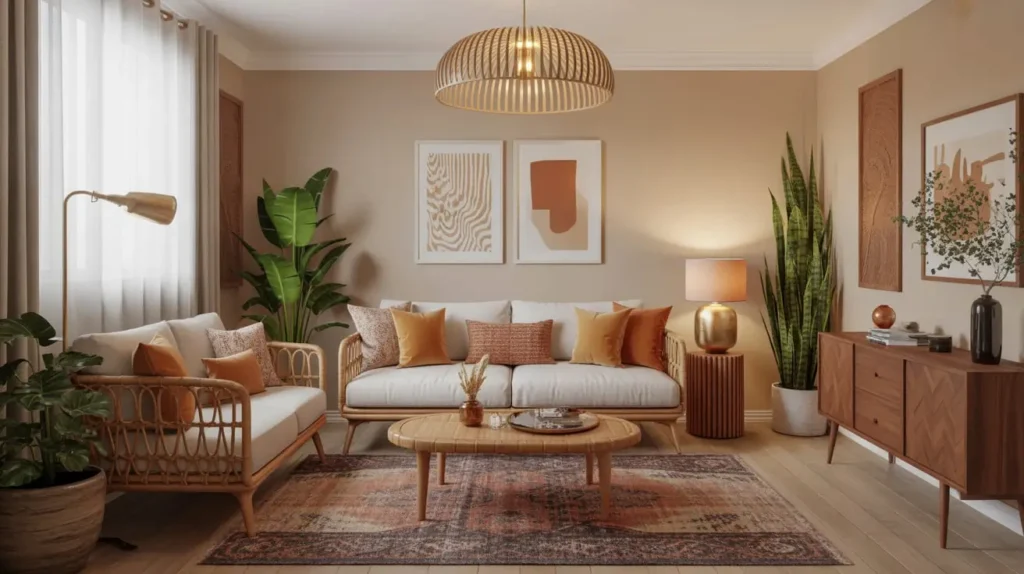
This is where the fun really begins. What happens when the structured, sophisticated world of Mid-Century Modern has a wild child with the free-spirited, earthy vibe of Bohemian style? You get a Mid-Century Boho Fusion, and let me tell you, it’s a match made in design heaven. This is for those of us who love the clean lines of an Eames chair but also can’t resist a good macrame wall hanging.
The trick to this fusion is balance. You’re blending the sleek, architectural forms of MCM with the soft, organic, and layered textures of Boho. Start with a solid MCM foundation: a streamlined sofa with tapered legs, a classic teak sideboard, maybe a geometric-patterned rug. This is your canvas.
Now, it’s time to layer in the Boho.
- Plants, plants, and more plants: Nothing says “bohemian” like a jungle of houseplants. Drape a pothos over your sideboard, place a tall fiddle-leaf fig in a corner, and scatter smaller succulents around. They add life, color, and a wonderfully untamed energy.
- Textile paradise: Mix and match pillows in various textures and patterns. Think Moroccan wedding blankets, mudcloth, and shibori prints. Throw a faux-sheepskin rug over a leather chair for instant coziness.
- Handmade touches: This is where you bring in the personality. A woven wall tapestry, handmade pottery, or a collection of baskets adds that personal, collected-over-time feel that is the heart of Boho style.
The result is a room that feels both sophisticated and deeply personal. It’s curated but not sterile, relaxed but not messy. It’s the perfect space for someone who appreciates high design but doesn’t take themselves too seriously.
4. Teak and Leather Statement Room

If you want a look that is unequivocally, unapologetically Mid-Century Modern, you cannot go wrong with the classic pairing of teak and leather. This combination is the peanut butter and jelly of MCM design. It’s timeless, it’s sophisticated, and it has a masculine-leaning edge that feels both powerful and incredibly comfortable.
Teak was a darling of mid-century designers for a reason. Its warm, golden-honey tone and durable nature made it perfect for creating furniture that was both beautiful and built to last. When you pair that with the rich, supple texture of a quality leather sofa or armchair, magic happens. The leather, especially as it ages and develops a beautiful patina, adds a layer of lived-in luxury that’s impossible to fake.
To create this statement room, let the materials do the talking. A cognac or tobacco-colored leather sofa is your anchor. It’s bold, it’s inviting, and it says, “I have my life together.” Now, build around it with teak. A Z-shaped side table, a long and low media console, or a bookshelf with clean, modular lines. Ever wondered why this combo works so well? It’s the contrast: the smooth, organic warmth of the wood against the rugged, rich texture of the leather.
To keep it from feeling too heavy or like a 1970s law office, bring in some lightness. A cream-colored shag rug, some crisp white walls, and a few brass or black metal accents in your lighting and decor will break things up beautifully. It’s a look that’s confident, cozy, and will only get better with age.
Also Read: 15 Creative Wall Decor Living Room Ideas That Wow Guests
5. Earth-Toned Vintage Aesthetic
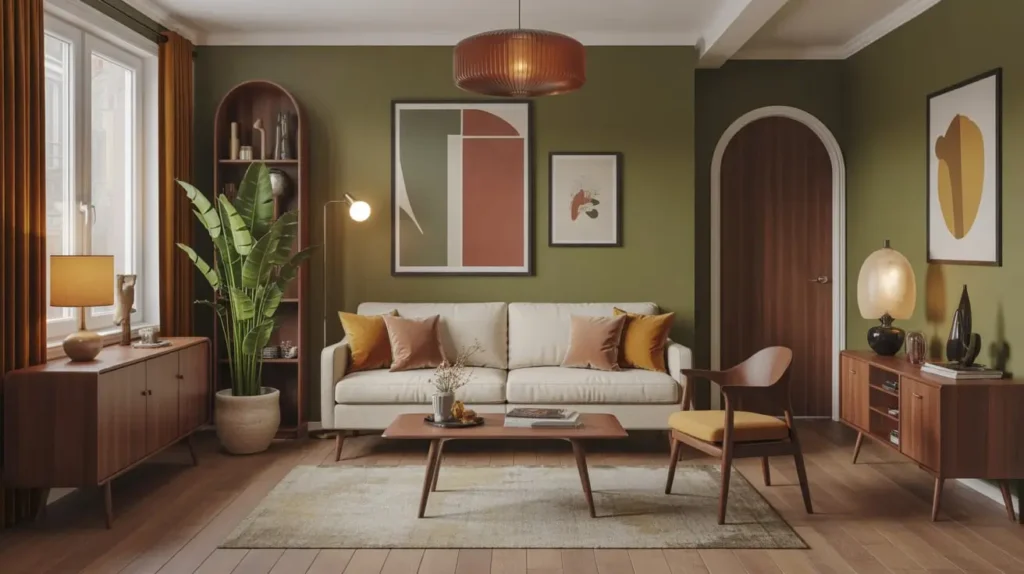
Let’s take a trip back in time, shall we? The mid-century era wasn’t just about bright, optimistic colors. There was a whole other side to the color palette, one deeply rooted in nature. We’re talking about those gorgeous, muted, earthy tones: avocado green, harvest gold, burnt orange, and deep mustard yellow. Sound a little dated? Not when you do it right.
Creating an earth-toned vintage aesthetic is about capturing the nostalgic warmth of the ’60s and ’70s without making your living room look like a set from That ’70s Show. The key is to use these colors as accents, not as an overwhelming flood. Think of them as spices in a recipe—a little goes a long way.
Start with a neutral base, like a warm white or a soft greige on the walls. Your main furniture, like the sofa, can be a calming neutral like charcoal grey, cream, or even a rich brown leather. Now, bring in the earth tones.
- A single statement piece: An armchair upholstered in a rich, mustard-yellow velvet. It’s bold, it’s luxurious, and it’s an instant focal point.
- Throw pillows and blankets: This is the easiest, lowest-commitment way to play with color. Mix and match pillows in avocado, burnt orange, and brown.
- Art and decor: Look for vintage-style prints or pottery that feature these colors. A large abstract painting with splashes of harvest gold can tie the whole room together.
This look is incredibly cozy because the colors themselves are inherently warm and grounding. They connect us to the natural world and evoke a sense of nostalgia and comfort. It’s a sophisticated, grown-up take on retro that feels both timeless and very of-the-moment.
6. Scandinavian Mid-Century Blend
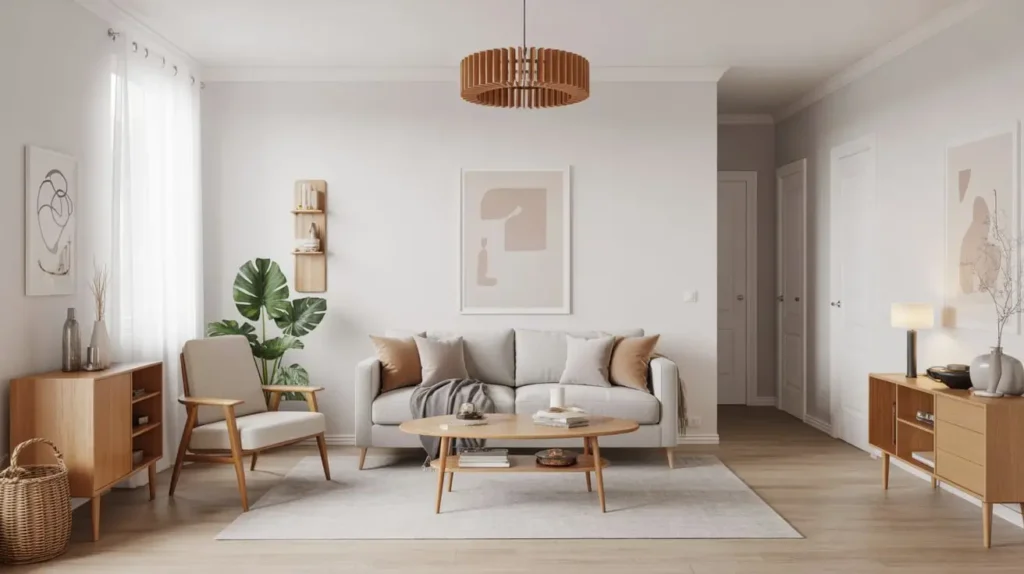
What do you get when you combine the functional, wood-focused aesthetic of Mid-Century Modern with the bright, airy, and minimalist principles of Scandinavian design? You get a style that is the absolute pinnacle of cozy, functional, and beautiful living. I’m a huge fan of this blend, BTW. It takes the best of both worlds to create something truly special.
Both MCM and Scandi design share a love for clean lines, natural materials (especially wood), and a “less is more” philosophy. Where they differ slightly is in the details. MCM often features darker woods like walnut and teak, while Scandi design leans towards lighter woods like birch, ash, and light oak. MCM can be a bit more sculptural and bold, while Scandi focuses on simplicity and “hygge” (that untranslatable Danish word for ultimate coziness).
To achieve this blissful union in your living room:
- Go for a light and bright foundation: White or very light grey walls are a must. This reflects natural light and creates that airy, open feeling so characteristic of Scandi style.
- Mix your woods: Don’t be afraid to pair a classic MCM walnut credenza with a lighter oak coffee table. The key is to keep the finishes natural and the shapes simple. This blending of light and dark woods adds depth and interest.
- Prioritize textiles: This is where the hygge comes in. Layer your space with textures. A soft wool rug, linen curtains, a sheepskin throw, and plenty of soft-hued pillows will make the clean lines of the furniture feel warm and inviting.
- Keep it uncluttered: Both styles value a clutter-free environment. Everything in the room should have a purpose. Use smart storage (like that MCM credenza) to hide away the mess.
The result is a living room that is bright, peaceful, and incredibly comfortable. It’s the perfect place to curl up with a good book and a cup of tea, no matter the season.
7. Bold Accent Wall Retro Style

Sometimes, cozy doesn’t mean quiet. Sometimes, cozy means enveloping a room in a rich, dramatic color that makes you feel like you’re getting a big, stylish hug. A bold accent wall is one of the fastest and most impactful ways to inject a serious dose of retro personality into your MCM living room.
Forget boring beige. We’re talking about deep, saturated colors that were popular during the mid-century period. Think deep teal, olive green, navy blue, or even a moody charcoal gray. The idea is to pick one wall—usually the one behind your sofa or your media center—and go all in. It creates an instant focal point and provides a stunning backdrop for your beautiful MCM furniture.
The contrast is what makes this work. Imagine your warm walnut sideboard or the tapered wooden legs of your sofa popping against a dark, dramatic teal wall. It’s pure visual drama. This is also a fantastic way to make a large, cavernous room feel more intimate and, you guessed it, cozy. Darker colors have a way of visually “pulling” the walls in.
A few tips to make this work:
- Choose the right wall: Pick a wall without too many windows or doors to get the maximum impact.
- Balance the dark with light: If you have a dark accent wall, keep the other walls and the ceiling a bright white to prevent the room from feeling like a cave.
- Use wallpaper: Don’t want to commit to paint? A bold, geometric-patterned wallpaper is another fantastic option for a retro accent wall. Look for patterns with starbursts, abstract shapes, or atomic-era motifs. It’s a bit of a commitment, but the payoff is huge.
This is a bold move, for sure, but fortune favors the brave, right?
8. Timeless Walnut Furniture Setup
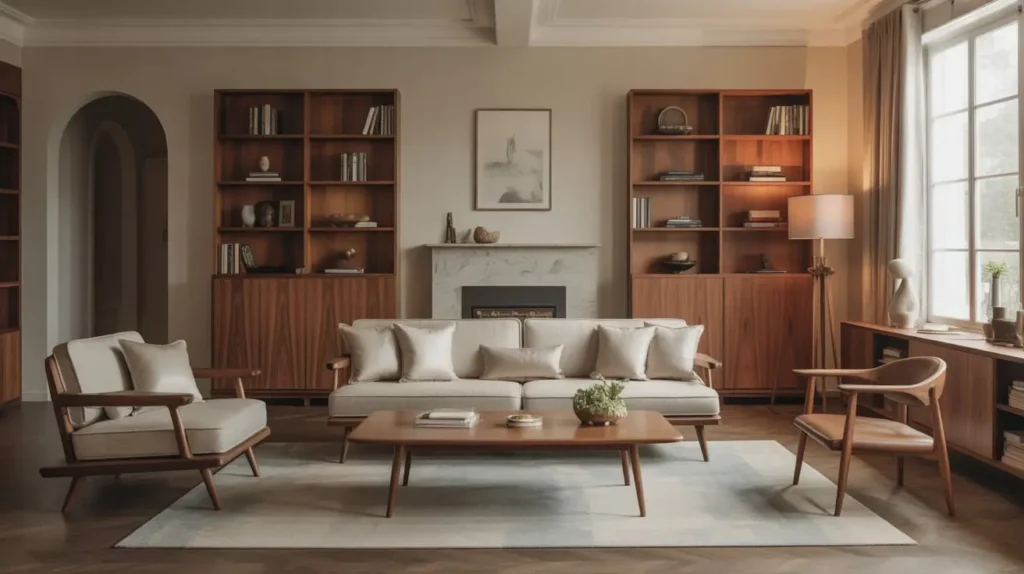
If teak is the fun, slightly-bohemian friend, walnut is its sophisticated, urbane cousin. When you think of high-end, classic Mid-Century Modern design, you’re probably picturing walnut. Its deep, rich, chocolatey-brown color, often with complex grain patterns, exudes a sense of quiet luxury and permanence. A living room centered around walnut furniture is a masterclass in timeless elegance.
I have a personal soft spot for walnut. There’s a weight and a seriousness to it that instantly elevates a space. A walnut furniture setup isn’t about fleeting trends; it’s an investment. These are the pieces you’ll have for a lifetime, the future heirlooms. Think of the iconic designs by folks like George Nelson or Florence Knoll—so many of them were realized in this gorgeous wood.
To create this look, focus on quality over quantity.
- The Centerpiece: A long, low credenza or media unit in a rich walnut is a perfect starting point. Its horizontal lines will anchor the room.
- The Supporting Cast: Add a coffee table with sculptural legs or a set of nesting tables. A bookshelf with a walnut frame and brass details is another classic choice.
- The Right Palette: Walnut pairs beautifully with a more restrained color palette. Think jewel tones like emerald green or sapphire blue for a sofa, or stick with classic neutrals like grey and cream to really let the wood be the hero. Brass and gold accents are walnut’s best friend, bringing out its warm undertones.
A walnut-centric living room feels grounded, intelligent, and incredibly refined. It’s cozy in a “settling into a leather-bound chair with a good book and a glass of whiskey” kind of way. It’s sophisticated comfort at its finest.
9. Geometric Pattern Living Space
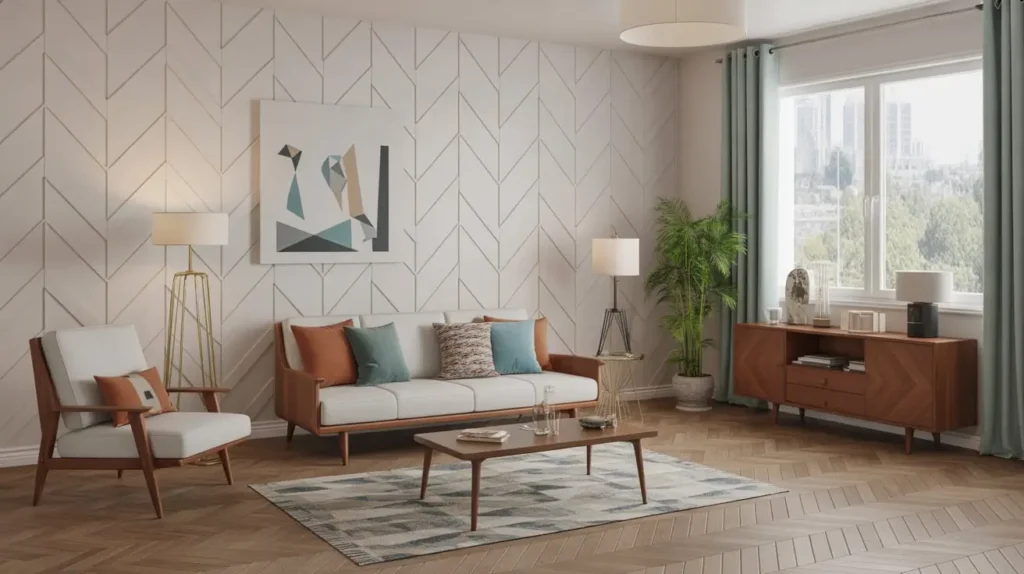
One of the defining features of Mid-Century Modern design is its love of bold, graphic, and often abstract patterns. Incorporating geometric patterns is a surefire way to add visual interest, energy, and a dose of retro fun to your living room. It’s the design equivalent of putting on a great, upbeat record.
This isn’t about going pattern-crazy and giving yourself a headache. It’s about strategic placement. The goal is to create rhythm and movement in the room, breaking up the solid blocks of color and the smooth surfaces of your wooden furniture. The patterns of the era were optimistic and forward-thinking, drawing from atomic-age imagery, abstract art, and nature-inspired-but-simplified forms.
Where can you introduce these patterns?
- The Rug: This is the big one. A large area rug with a bold geometric pattern can define the entire seating area and serve as the room’s primary piece of “art.” Look for patterns with intersecting lines, sunbursts, or abstract blobs of color.
- Throw Pillows: The easiest entry point. Get a few pillows with different but complementary geometric prints. Mix a simple stripe with a more complex abstract pattern. As long as they share a color or two, they’ll work together.
- Curtains: Feeling bold? A pair of curtains with a subtle geometric print can add a layer of sophistication and visual texture.
- Wall Art: Framed prints of abstract geometric art are a classic MCM move. Group a few smaller ones together or go for one large, impactful piece.
The key is to balance the pattern with plenty of negative space. If you have a bold rug, keep your sofa a solid color. If you have patterned pillows, let the rug be more subdued. It’s a dance, and when you get the steps right, your living room will feel dynamic, personalized, and full of life.
Also Read: 15 Creative Living and Dining Room Combo Ideas You’ll Love
10. Modern Retro Apartment Decor
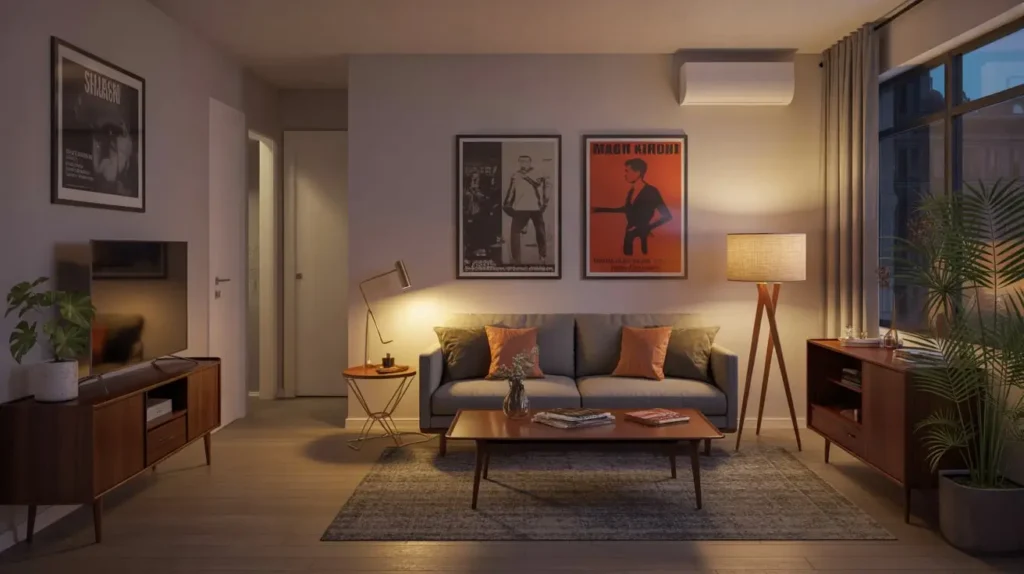
Living in an apartment often means dealing with smaller spaces and, let’s be real, landlord-beige walls you can’t always change. But that doesn’t mean you can’t have a killer MCM living room. In fact, the principles of MCM design are perfect for apartment living. Why? Because the furniture was designed to be beautiful, functional, and often, multi-functional.
The mantra for a modern retro apartment is “smart, stylish, and space-conscious.” MCM furniture often features a lighter-on-its-feet design.
- Tapered Legs: Look at any classic MCM sofa, chair, or sideboard. See those skinny, angled legs? They lift the furniture off the ground, which creates an illusion of more floor space. This is a game-changer in a small room, making it feel more open and airy.
- Low-Profile Silhouettes: Many MCM sofas and chairs have low-slung profiles. This keeps the sightlines in the room open and unobstructed, which also contributes to a feeling of spaciousness.
- Multi-functional Pieces: Think of a storage bench that doubles as a coffee table, or a credenza that serves as a TV stand, bar, and general-stuff-hider all in one. These pieces work hard, so you don’t need as much furniture.
To make it cozy, focus on vertical space. Use tall, open-backed bookshelves to draw the eye upward. Hang a plant from the ceiling. Use a tall, slim floor lamp instead of a bulky table lamp. And, of course, layer in those cozy textiles—a soft rug, throws, and pillows are non-negotiable. It’s all about creating a functional, stylish oasis, no matter the square footage.
11. Color Pop Mid-Century Design
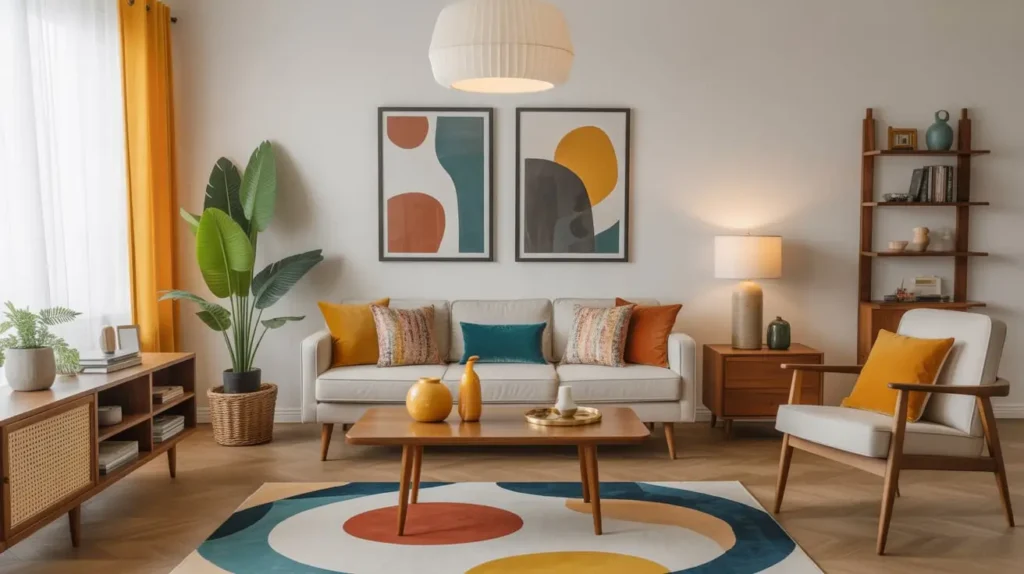
While earth tones are one side of the MCM coin, the other side is all about bright, optimistic, and downright joyful pops of color. This is the post-war optimism of the 1950s captured in a design aesthetic. It’s about injecting energy and personality into a room with a well-placed, unexpected burst of color. It’s the wink and a smile in your living room.
The trick here is to use color as a deliberate, surgical strike. Your room is a neutral, sophisticated canvas—think grey sofa, white walls, walnut furniture. Then, BAM! You hit it with a pop of turquoise, sunny yellow, atomic orange, or even a punchy pink.
Where do you deploy this color weapon?
- A Single Chair: An armchair or a side chair upholstered in a vibrant hue is a classic move. It becomes a functional piece of sculpture.
- Decor and Accessories: This is the low-risk, high-reward option. A set of turquoise vases on your credenza, a sunny yellow table lamp, or a collection of books with brightly colored spines.
- The Front Door (if you can): If your living room opens near your front door, painting the inside of the door a bold color is an amazing, unexpected touch.
- A piece of art: A large abstract painting that is mostly neutral but has a slash of vibrant red can be the thing that ties your subtle color pops together.
The beauty of this approach is its restraint. It’s not a full-on color assault. It’s the one or two carefully chosen moments of brightness that make the whole room sing. It shows confidence and a playful spirit, and it keeps your sophisticated MCM space from taking itself too seriously. IMO, this is one of the most fun ways to personalize the style.
12. Vintage Lighting Statement Room

Let’s talk about the jewelry of a room: the lighting. In a Mid-Century Modern living room, lighting isn’t just a utility; it’s a primary design element. The designers of the era were obsessed with new materials and technologies, and they created some of the most sculptural, innovative, and flat-out cool light fixtures ever. Making one of these fixtures the star of your room is a power move.
A statement light fixture can set the entire tone for the space. It can be a conversation starter, a piece of art, and a source of warm, ambient light all at once. What kind of fixtures are we talking about?
- The Sputnik Chandelier: Is there anything more quintessentially mid-century? This explosive starburst of arms and bulbs is pure atomic-age drama. Hung over a seating area, it’s an instant showstopper.
- The Arc Lamp: A large, sweeping arc lamp, often with a marble base, is both incredibly practical and visually stunning. It can provide overhead light for a sofa without needing to be wired into the ceiling. It’s functional sculpture.
- Multi-Globe Pendants: Fixtures with clusters of globes in smoked, white, or colored glass create a soft, diffused glow and a strong graphic statement.
- Sculptural Table Lamps: Look for lamps with interesting bases made of ceramic, wood, or metal, topped with a simple drum shade.
Finding authentic vintage lighting can be a treasure hunt, but it’s worth it. Flea markets, antique stores, and online marketplaces are your hunting grounds. A genuine vintage piece has a story and a patina you can’t replicate. Even a good-quality reproduction of a classic design will do the trick. The point is to think of your lighting not as an afterthought, but as a centerpiece.
13. Sleek Low-Profile Furniture Look
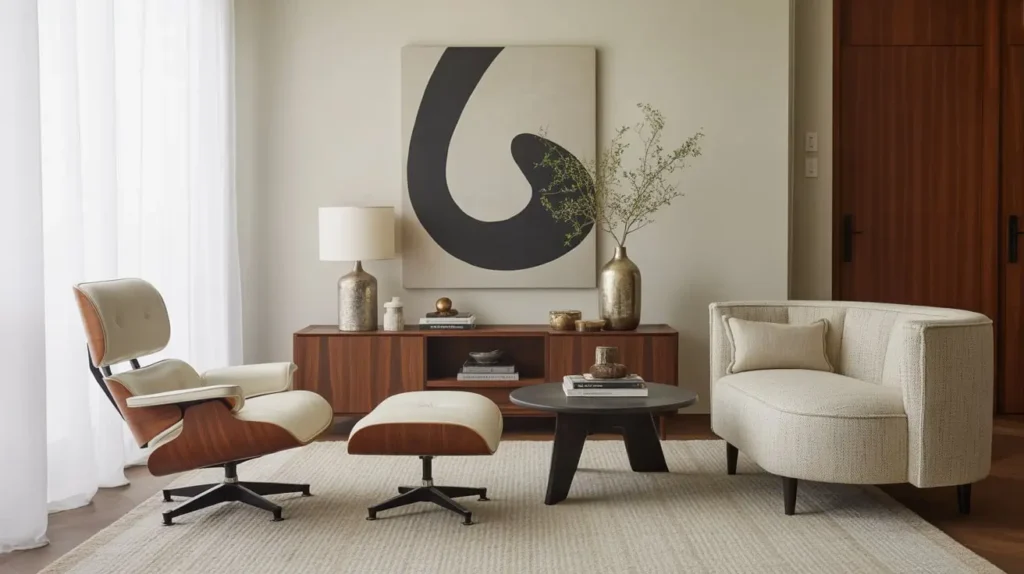
There’s something undeniably cool and lounge-like about a room filled with low-profile furniture. It’s a look that encourages relaxation and conversation. It’s less formal, more intimate, and a hallmark of authentic Mid-Century Modern design. This aesthetic is all about bringing the furniture down to a more human, accessible level.
Think about it: a sofa that sits low to the ground, a coffee table that’s barely knee-high, and chairs that invite you to sink in rather than sit up straight. This creates long, clean, horizontal lines across the room, which makes the space feel wider and more serene. It’s the visual equivalent of a deep, calming breath. My own sofa is a low-slung model, and I can confirm it makes a weekend movie marathon feel about 100% more luxurious.
To get this look, seek out sofas and sectionals with short legs (or no visible legs at all) and low-backed cushions. Pair them with a “plinth” style coffee table—a solid, blocky table that sits directly on the floor. For seating, think of low-slung sling chairs or floor-hugging lounge chairs.
The potential downside? If you or your guests have bad knees, getting up can be an adventure. But what you sacrifice in vertical lift, you gain in style points. To balance the low-slung look and keep it from feeling squashed, draw the eye upward with other elements. A tall, skinny floor lamp, a high-hung piece of art, or curtains hung close to the ceiling will provide the necessary vertical contrast. This creates a dynamic tension that is a signature of great design.
14. Classic Eames-Inspired Interior
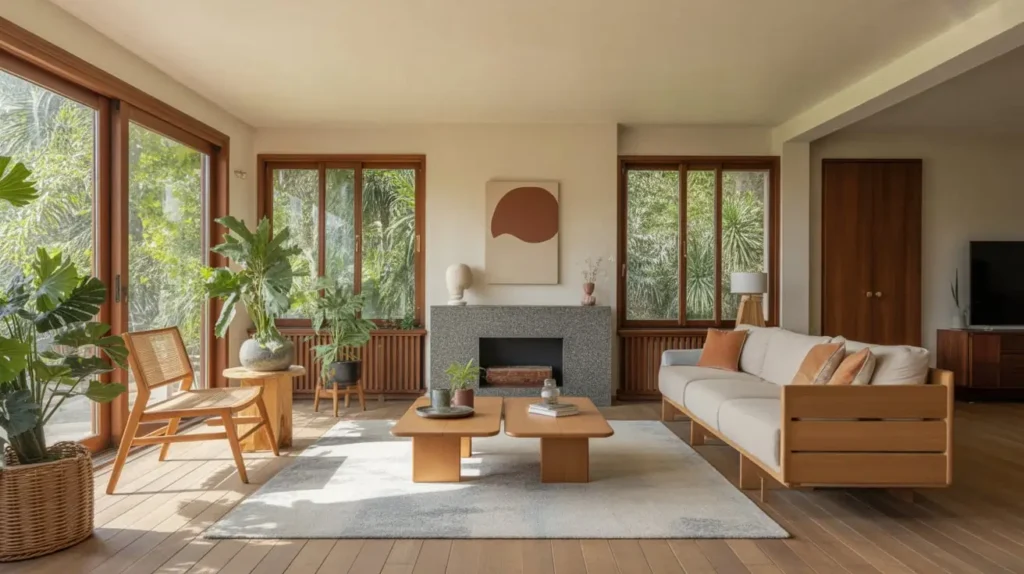
You can’t talk about Mid-Century Modern without talking about Charles and Ray Eames. And you can’t talk about cozy MCM living rooms without mentioning their masterpiece: the Eames Lounge Chair and Ottoman. Seriously, if comfort were a chair, this would be it. Designed in 1956, it was intended to have the “warm, receptive look of a well-used first baseman’s mitt.” They nailed it.
An entire interior can be built around this one iconic piece. It’s more than a chair; it’s a destination. It’s the designated spot for reading, listening to music, or simply contemplating your excellent life choices. Placing an Eames-style lounger in your living room is an immediate declaration of your commitment to both style and serious comfort.
Now, let’s address the elephant in the room: a brand-new, authentic one costs a small fortune. A very large fortune. But don’t despair!
- The Investment: If you can swing it, buying an authentic one is an investment that will hold its value and bring you joy for decades.
- The Vintage Hunt: You can sometimes find vintage ones for less, though they are highly sought-after. The hunt is part of the fun!
- The “Inspired” Route: There are many high-quality reproductions and “Eames-inspired” chairs out there. Do your research, read reviews, and find one that captures the spirit and comfort of the original without requiring you to sell a kidney. No judgment here. 🙂
Pair your lounger with a simple, elegant supporting cast. A Noguchi-style coffee table, a clean-lined sofa, and a soft, plush rug. The chair is the star; everything else is there to applaud it. It’s the ultimate cozy corner, the perfect blend of high design and pure, unadulterated relaxation.
15. Nature-Inspired Mid-Century Haven
At its core, Mid-Century Modern design was deeply connected to the natural world. Designers sought to blur the lines between indoors and outdoors, using organic shapes, natural materials, and large windows to bring the beauty of nature inside. Creating a nature-inspired MCM haven is a wonderful way to foster a sense of calm and tranquility in your living room.
This goes beyond just adding a few plants (though that’s a great start). It’s about a holistic approach. It’s about mimicking the forms, colors, and textures of the natural world.
- Organic Shapes: Look for furniture with soft, curved lines instead of sharp, right angles. A kidney-shaped coffee table, a sofa with rounded arms, or a chair with a curved, shell-like back all evoke a more natural, organic feel. The famous Tulip Chair by Eero Saarinen is a perfect example of this.
- Natural Materials: We’ve talked about wood, but also consider other natural materials. A slate or stone hearth for a fireplace, a jute or sisal rug, and linen or cotton textiles all contribute to an earthy, grounded feeling.
- A Nature-Based Palette: Build your color scheme around the colors you’d find on a walk in the woods. Shades of green, from moss to olive; browns, from sand to deep soil; and blues, from a pale sky to a deep lake.
- Let There Be Light: If you’re blessed with large windows, make the most of them! Use sheer curtains that allow natural light to flood in. Position your seating to take advantage of the view.
This approach creates a living room that feels like a sanctuary. It’s a calm, restorative space that connects you to the outdoors, even when you’re cozied up on the sofa. It’s a reminder that great design is, and always has been, inspired by the world around us.
So, Ready to Get Cozy?
There you have it. Fifteen ways to take the undeniably cool, clean-lined world of Mid-Century Modern and make it feel like a warm, welcoming hug. It’s not about turning your home into a time capsule; it’s about taking the best principles of this timeless style—functional beauty, honest materials, and a touch of playful optimism—and making them your own.
The biggest takeaway? MCM and cozy are not mutually exclusive. Far from it. Coziness comes from texture, from personal touches, from a layout that invites you to live in it, not just look at it. It comes from a soft rug underfoot, a chair that was literally designed to feel like a baseball glove, and the warm glow of a vintage lamp.
Now it’s your turn. Which idea are you totally stealing first? Don’t worry, I won’t tell the design police. The most important rule of decorating is that you have to love the space you live in. So go ahead, find that perfect teak credenza, throw a sheepskin over that Eames-inspired chair, and create a cozy Mid-Century Modern living room that is 100% you.





